Topic 1:
LeetCode——203. 移除链表元素
203. 移除链表元素 - 力扣(LeetCode)

移除链表中的数字6
操作很简单,我们只需要把2的指向地址修改就好了,原来的指向地址是6现在改为3
这个思路是完全正确的,但是在链表中增加或删除元素是很麻烦的,我们需要判断前后是否为空指针,情况很多。
我们利用这个思路,可以推广另外的做法,把不是6的元素尾插到一个新链表,这样就可以去除所有6
/** * Definition for singly-linked list. * struct ListNode { * int val; * struct ListNode *next; * }; */struct ListNode* removeElements(struct ListNode* head, int val){ if(head==NULL) { return NULL; } struct ListNode* cur =head;//利用另外的变量遍历 //哨兵防止空指针 struct ListNode* newnode=(struct ListNode*)malloc(sizeof(struct ListNode)); newnode->next=NULL; struct ListNode* tail=newnode;//记录下次尾插的作用 while(cur) { if(cur->val!=val) { tail->next=cur;//尾插到哨兵后面 tail=tail->next;//尾向后 cur=cur->next;//指针向后 } else { struct ListNode* tmp=cur->next;//存下一个,我们释放当前位置 free(cur); cur=tmp; } } tail->next=NULL;//到尾了 head=newnode->next;//去除哨兵 free(newnode); return head;}
Topic 2:
LeetCode——876. 链表的中间结点
876. 链表的中间结点 - 力扣(LeetCode)
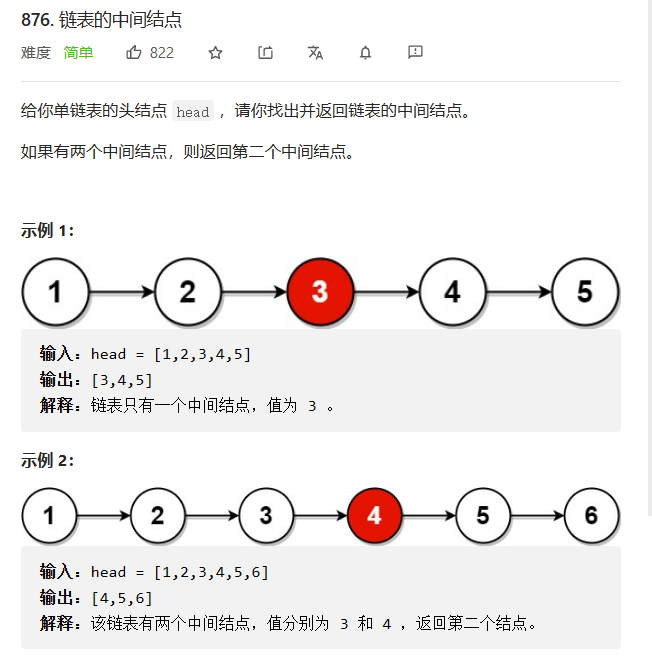
找中间很简单,但是假如我们要求时间复杂度为O(N)
我们应该怎么去做?小明一次走一步,小华一次走两步,当小华走完全程的时候,小明走的路程刚刚好是全部路程的一半。通过这个例子,我们可以明白,我们可以定义两个指针来进行查找中间的节点。这种方法叫做快慢指针。
/** * Definition for singly-linked list. * struct ListNode { * int val; * struct ListNode *next; * }; */struct ListNode* middleNode(struct ListNode* head){ struct ListNode* fast=head; struct ListNode* slow=head; while(fast && fast->next)//当元素是奇数个时fast->next为NULL;当元素为偶数个fast为NULL是结束标志 { fast=fast->next->next; slow=slow->next; } return slow;}
Topic 3:
链表中倒数第k个结点
链表中倒数第k个结点_牛客题霸_牛客网 (nowcoder.com)
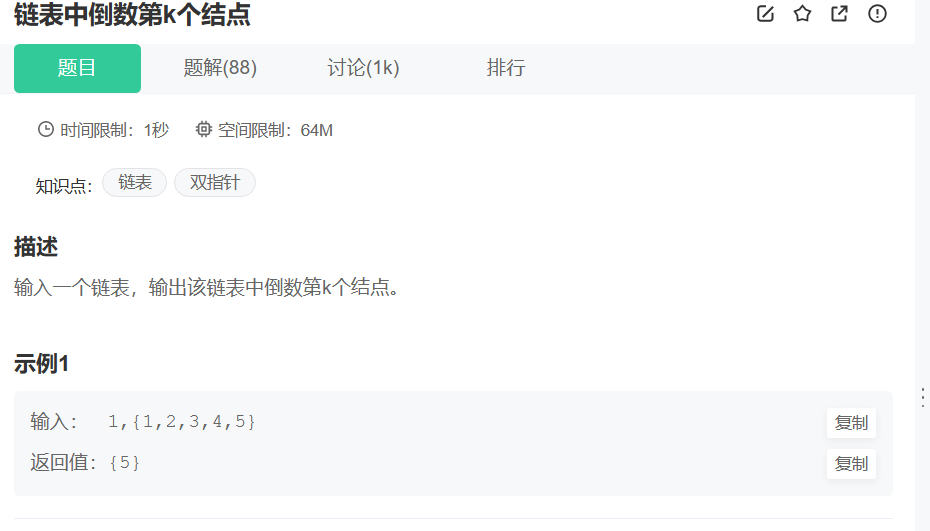
链表的倒数第k个元素
我们先处理极端情况:链表为空的时候;k大于链表元素个数
把极端情况处理完,我们思考,当时间复杂度为O(N)时,我们应该怎么样得到倒数第k的节点。倒数第k个就是正数的第n-k个,我们定义两个指针,一个先走k步,然后两个指针同时走,当先走k步的指针到结尾的时候,我们第二个指针就是走到了n-k的位置。
/** * struct ListNode { * int val; * struct ListNode *next; * }; *//** * * @param pListHead ListNode类 * @param k int整型 * @return ListNode类 */struct ListNode* FindKthToTail(struct ListNode* pListHead, int k ) { struct ListNode* fast=pListHead; struct ListNode* slow=pListHead; if(pListHead==NULL) { return NULL; } while(k--)//先走k步 { if(fast==NULL)//链表的元素小于k { return NULL; } fast=fast->next; } while(fast) { fast=fast->next; slow=slow->next; } return slow;}
Topic 4:
链表分割
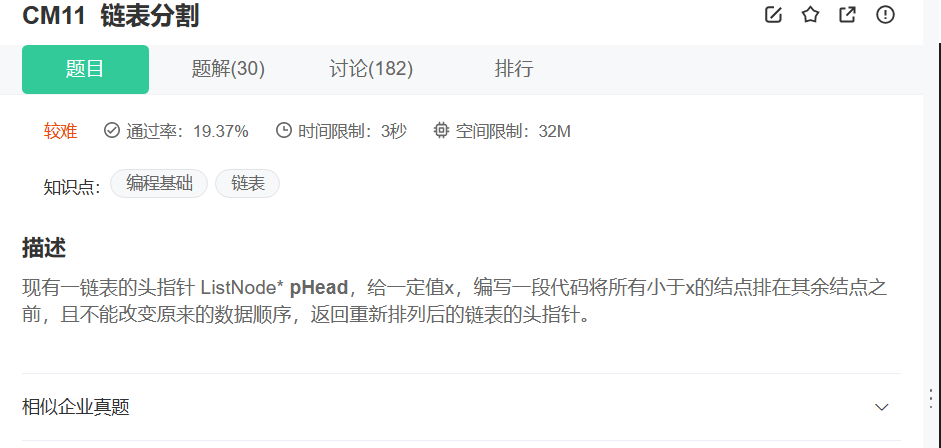
我们先解读题目,给一个链表,给定一个值x,大于x的放后面,小于x的放前面。不改变原来的数据顺序即,原来小于x的值是,4 2 1,我们不改变想对位置 4 2 1.
题目理解清楚了,我们怎么做呢,我们创建两个链表,一个存小于x的值,一个存大于等于x的值,然后连接起来,这样他们的相对位置就没有改变。
/*struct ListNode { int val; struct ListNode *next; ListNode(int x) : val(x), next(NULL) {}};*/class Partition {public: ListNode* partition(ListNode* pHead, int x) { struct ListNode* gguard;//存大于等于x的数据得哨兵 struct ListNode* lguard;//存小于x的哨兵 struct ListNode* gtail;//存大于x的尾 struct ListNode* ltail;//存小于x的尾 struct ListNode* cur=pHead; gguard=gtail=(struct ListNode*)malloc(sizeof(struct ListNode));//申请哨兵 lguard=ltail=(struct ListNode*)malloc(sizeof(struct ListNode));//申请哨兵 gtail->next=ltail->next=NULL;//哨兵后面一个置空 while(cur) { if(cur->val>=x) { gtail->next=cur;//哨兵后面接插入的链表 gtail=gtail->next;//尾向后移 } else { ltail->next=cur; ltail=ltail->next; } cur=cur->next; } ltail->next=gguard->next;//连接两个链表 gtail->next=NULL;//新链表的最后要置空 pHead=lguard->next; free(lguard); free(gguard); return pHead; }};
Topic 5:
反转链表
206. 反转链表 - 力扣(LeetCode)
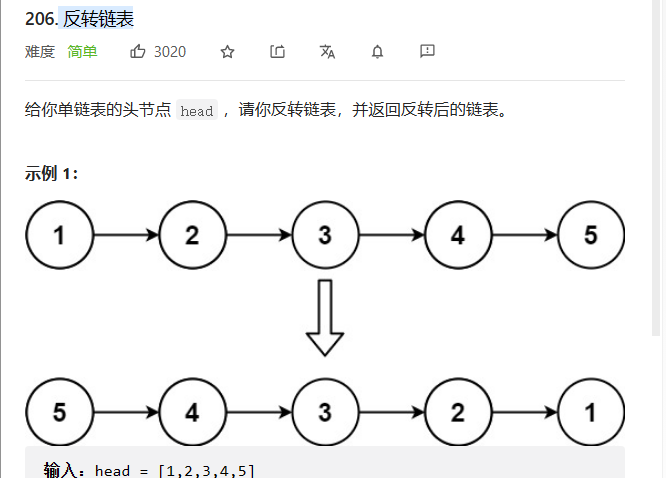
反转链表,我们可以利用头插的思路,即我们建立一个新的链表,把一个一个元素头插到第一个,最后插入的元素就是新的头,第一个插入的元素就是新的尾。头插最最要的是更新新的头,新的头就是新插入的元素的地址。
/** * Definition for singly-linked list. * struct ListNode { * int val; * struct ListNode *next; * }; */struct ListNode* reverseList(struct ListNode* head){ if(head==NULL) { return NULL; } struct ListNode* cur=head; struct ListNode* newnode=NULL; while(cur) { struct ListNode* next=cur->next;//存下一个,防止找不到 cur->next=newnode;//将链表第一个元素指向newnode指针,下面依次指向 newnode=cur;//更新newnode,让newnode一直指向链表的开头 cur=next;//链表向后移 } return newnode;}
Topic 6:
链表的回文结构
链表的回文结构_牛客题霸_牛客网 (nowcoder.com)
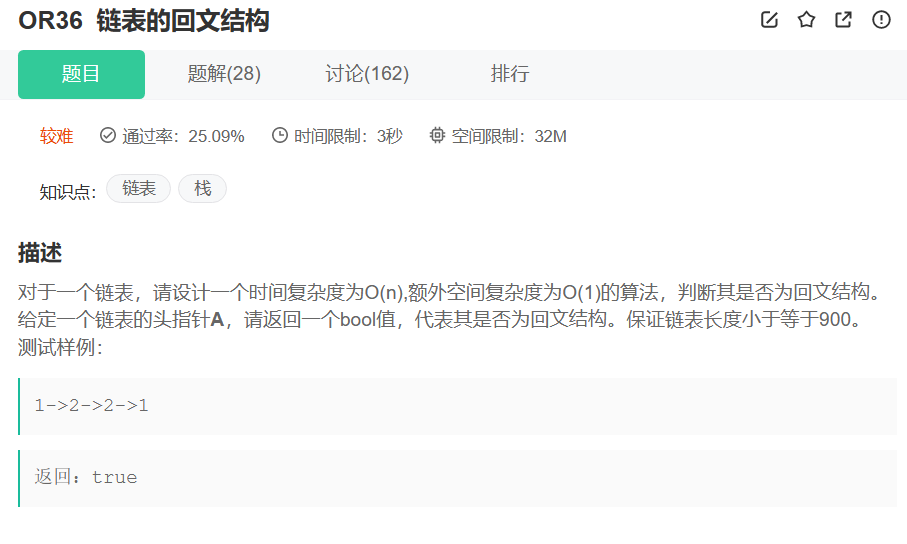
链表的回文,怎么判断。我们最直接的方法是,找到中间节点,反转中间节点,得到翻转的链表,与前半段链表比较。如果前半段链表与,后半段链表翻转后的元素都相等,说明这个链表是回文链表。
/*struct ListNode { int val; struct ListNode *next; ListNode(int x) : val(x), next(NULL) {}};*/struct ListNode* reverseList(struct ListNode* head){ if(head==NULL) { return NULL; } struct ListNode* cur=head; struct ListNode* newnode=NULL; while(cur) { struct ListNode* next=cur->next; cur->next=newnode; newnode=cur; cur=next; } return newnode;}struct ListNode* middleNode(struct ListNode* head){ struct ListNode* fast=head; struct ListNode* slow=head; while(fast && fast->next)//当元素是奇数个时fast->next为NULL;当元素为偶数个fast为NULL是结束标志 { fast=fast->next->next; slow=slow->next; } return slow;}class PalindromeList {public: bool chkPalindrome(ListNode* head) { struct ListNode* mid=middleNode(head);//找到中间节点 struct ListNode* rhead=reverseList(mid);//反转中间节点后的元素 while(rhead) { if(head->val==rhead->val) { head=head->next; rhead=rhead->next; } else { return false;//不相等说明不是回文 } } return true; }};
Topic 7:
相交链表
160. 相交链表 - 力扣(LeetCode)
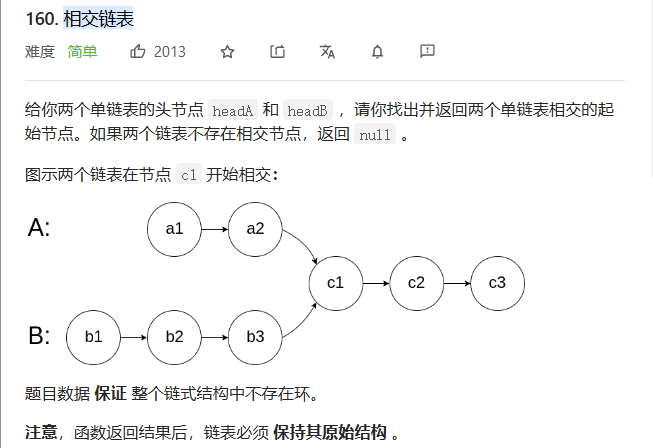
怎么判断链表相交,我们需要看链表的地址是否有相等的,如果我们利用两个for循环来实现判断是否有相等的地址,我们的时间复杂度就是O(N^2),,这个时间复杂度是很大的。我们还能通过什么方法来判断呢?相交的链表有共同的特点,就是它们有共同的尾,我们只需要判断尾的地址是否相等就好,如果尾的地址相等,我们就说明它们是相交的链表。
相交的链表,如何寻找第一个交点,全部遍历一遍,这个好像不太可能。既然链表有交点,第一个交点到链表尾的距离相等,而头到链表交点的距离就不一定相等了,它们的差值刚刚好是两个链表距离的差值。我们让长链表先走它们的差值,然后一起走,等它们的地址相等的时候就是它们的第一个交点。
/** * Definition for singly-linked list. * struct ListNode { * int val; * struct ListNode *next; * }; */struct ListNode *getIntersectionNode(struct ListNode *headA, struct ListNode *headB) { struct ListNode* cur1=headA; struct ListNode* cur2=headB; int n1=1;//赋值1是因为统计链表长度的时候,我们的最后的一个位置,我们统计到 int n2=1; while(cur1->next)//找headA的尾 { cur1=cur1->next; ++n1; } while(cur2->next)//找headB的尾 { cur2=cur2->next; ++n2; } if(cur1!=cur2) { return NULL; } int dif=abs(n1-n2);//让长的先走 cur1=headA; cur2=headB; if(n1>n2) { while(dif) { cur1=cur1->next; dif--; } } else { while(dif) { cur2=cur2->next; dif--; } } while(cur1!=cur2) { cur1=cur1->next; cur2=cur2->next; } return cur1;}